Floating above the earth now like one of his weightless figures, Marc Chagall might look kindly on the recent renaissance of American Jewish culture. The mixing of Jewish motifs and secular styles; the combination of biblical themes and contemporary events; the use of playfulness to recover, even after last century’s tragedy, the joie de vivre of the Jewish folk: the Russian painter’s colorful, surreal, shtetl-inspired work is a model for Jews now creating inspiring Jewish lives while still being firmly connected to secular culture.
Of course Chagall himself (a lapsed Jew who is buried in a Christian graveyard in France) isn’t exactly a poster child for how art can lead to a more robust Jewish community. And yet, as I rediscovered recently at the new Chagall retrospective at the San Francisco Museum of Modern Art, there are a couple of important lessons the Jewish community can learn from his work.
1) Jewish artistic and religious inspiration share more than we realize. Chagall deeply believed that his paintings of couples trying to fly to heaven and wide-eyed Torah scholars taking their snuff were a form of religious expression. As he often said, his art was a mediator between Heaven and Earth. This is a primary reason why so many of his paintings are based on biblical themes.
Using contemporary artistic ideas to make the biblical stories come alive, sometimes connecting them to current political or social events, Chagall was doing then what many artists are doing today: renewing the Torah through the language of modern art. The stage scenery and paintings of Archie Rand and Tobi Kahn, for instance, or the music and lyrics of Liz Swados and Steve Reich, have made the stories of the Bible seem relevant and beautiful for many people. Chagall is a precursor of today’s experimental artist who chooses, against artistic fashions, to follow her heart and paint the Bible as if it were the trendiest subject imaginable.
2) Art can rejuvenate us spiritually. As I looked at Chagall’s vibrant, dynamic paintings of shtetl life, with his huge green-faced fiddlers and floating brides, I felt acutely both the loss of this civilization to the Holocaust, and its immense vitality. Chagall’s inspirations were the Jewish folklore of his childhood, and his wife, Bella. Both inspirations ceased to exist in the 1940s, with the Nazis destroying the rural Jewish civilization represented by Chagall’s hometown of Vitebsk, and Bella dying in 1944, at the height of the Nazi madness.
During the ’30s, ’40s, and ’50s, Chagall created some very powerful paintings depicting the destruction of European Jewry, often times using provocative Christian imagery like crucifixions. But apart from this work, what is interesting about Chagall’s postwar paintings is that they never lost the spirit of play and human possibility.
As I watched Chagall’s artistic vision unfold decade by decade at the exhibit, I began to hear the neo-chasidic songs of Shlomo Carlebach playing in my head. The late Carlebach’s genius was in recovering the lost songs of European Jewish life, especially the spiritually uplifting ones that are now a staple of synagogues and summer camps around the world. These songs became more insistent while I was looking at the third of a triptych of paintings. Composed during and after the war years, the first two of these paintings ("Resistance" and "Resurrection") use Chagall’s trademark bright colors and disorienting perspectives to document, a la Picasso’s "Guernica," what happened to Jewish life during the war: the burnings, the killings, the exile. But the third painting, "Liberation," show a Jewish wedding, full of music and dancing, proceeding despite the tragedy that has come before it. The message, of course, is that God did not withdraw his love for the Jewish people: for all people. The "proof" for Chagall is that music is still played, and so angels must still be acting as God’s artistic messengers to humankind.
Despite Chagall’s losses of family and community, he continued to paint themes of Jewish spiritual renewal throughout the rest of his life. For a Jewish community struggling to overcome the legacy of the Holocaust, as well as the joylessness of Israel’s perpetual struggles in a volatile Middle East, Chagall’s heartfelt, joyous work should be an inspiration to us.
The New York Jewish Week brings you the stories behind the headlines, keeping you connected to Jewish life in New York. Help sustain the reporting you trust by donating today.




